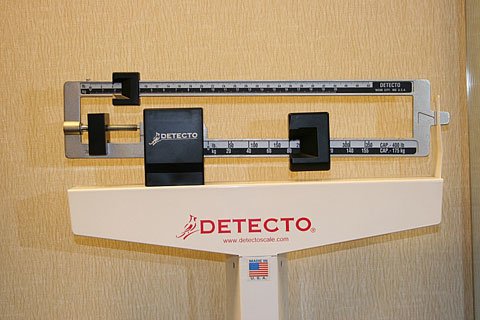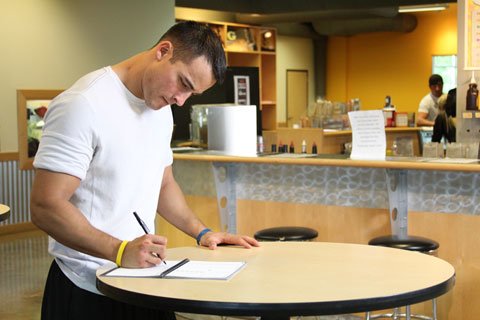The Idiots Guide To Testing Your Body Fat
If you're about to embark on a fitness and diet program, one tracking measurement that you'll want to make sure you're doing is to test your body fat percentage. So many people have a tendency to weigh in each and every morning on their bathroom scale and let that be the judge of how well they're progressing along. The problem with doing this however is that the scale only gives you a raw measurement of what your body weight is. It does not tell you what percentage of your body is lean body mass and which percentage is fat mass.
If you've spent any time reading health and fitness information, you know by now that it's body fat that you're targeting. The last thing you want to do is start losing lean muscle mass, so by using a body fat test to gauge your progress you can be sure that it's fat mass that you're losing.
Also keep in mind that some beginners may very well lose fat and gain muscle at the same time, so this would actually show up as a solid weight gain on the scale, leading to utter disappointment. When you're testing body fat though, you would see your body fat going down, therefore know you're right on track with where you should be. But how do you get a firm and accurate assessment of body fat? That's where the question comes in.

Stepping On The Scale Won't Give
You The Full Story On Your Progress.
You could use one of those hand-held devices that are so popular in many health clubs, however it's important to understand that these tend to be highly inaccurate and can be largely swayed by drinking even just one glass of water. Instead, turn to body fat calipers. This is a simple tool that you use to pinch certain areas of the body that will give a much more reliable estimation of your total body fat.
Let's take a look at how exactly you use these calipers so you can understand exactly how to measure your body fat.
Using Your Skin Calipers
The very first thing you'll need to do is get a hold of some skin fold calipers. It's with this tool that you'll use to gently pinch the skin creating a 'skin fold', upon which you'll place each arm of the calliper.
When you do this, the calliper will then give you a thickness reading, which indicates how many millimeters thick that skin fold is. The idea is that the more body fat you have on your body, the thicker this skin fold will be, so then when you put those measurements into a body fat calculator, you will get an estimate of what your total body fat percentage is.
Can You Pinch and Inch? Where To Take Your Measurements
So where do you pinch an inch?
When testing your body fat you can either use a three point test or a seven point test depending on just how accurate you want to be. Since the seven point test will asses a greater number regions on the body, these do tend to be superior over the three point test.
When doing the test on your body, you want to always use the right side for consistency purposes. You are to raise the skin fold on the area of the body and then wait two seconds after placing the calipers on the fold to ensure accuracy. Take two total measurements for each location so you can ensure they are all within close range of each other. You can use the average of these numbers if you like or just use whichever you prefer. Note though that if the measurements differ by more than a few millimeters, a third measurement should be completed.
Here are the places to measure:
Chest
Using a diagonal pinch mark that is located half way between the armpit and the nipple area. If you're a woman doing this test you should use a pinch that is about one third of the way from the arm pit to the nipple to get a better recording and to get far enough away from the breast tissue.
Chest
Watch The Video - 0:08
Midaxillary
To take this measurement, raise the arm above the head and then have the partner pinch the skin just below the nipple area on the side of the body.
Subprailiac
This location is on the front of the body just above where you see the bone of the hip.
Abdominal
Go directly to the side of your belly button about one inch and take the pinch.
Abdominal
Watch The Video - 0:11
Thigh
For the thigh measurement, you are to draw an imaginary line down halfway between the knee and the very top of the thigh and take the recording right in the center of the leg.
Thigh
Watch The Video - 0:08
Triceps
As the back of the triceps is one place many people tend to store most of their body fat, for this one you'll simply pinch the back of the arm about halfway between the shoulder and the elbow where you can tell most of the fat is located.
Tricep
Watch The Video - 0:06
Subscapular
The final region to test is the subscapular region which is just directly below where the bone of the shoulder blade is located.
Since the seven point test is the most accurate for recording purposes, it's highly recommended that you use it to determine your measurements. This will provide a very good idea of exactly what is going on with your body fat percentage.
Utilizing The Body Fat Formula
So once you have all your measurements taken and recorded, then it's time to put those measurements into terms that mean something for you.
The most popular body fat measurement equation to use is the Jackson-Pollock equation and is listed below. For this one you will first figure out your overall bone density and from that you will use it to estimate your body fat percentage.
Here is the formula for males:
- Bone Density = 1.112 (0.00043499 * (the sum of all seven measurements) + (0.00000055 * Sum of seven measurements squared) - (0.00028826 * age in years)
- Once you have your bone density figured out, then to calculate your body fat percentage you use:
- Body Fat Percentage = [(4.95/Bone Density) - 4.5] * 100
Here is the formula for females:
- Bone Density = 1.097 (0.00046971 * (the sum of all seven measurements) + (0.00000056 * Sum of seven measurements squared) - (0.00012828 * age in years)
- Once you have your bone density figured out, then to calculate your body fat percentage you use:
- Body Fat Percentage = [(4.95/Bone Density) - 4.5] * 100
What These Numbers Mean
So what does the final number you arrived at mean?
This number represents which percentage of your total body mass is represented by body fat. So for example, let's say you weigh 150 pounds and you discovered that your body fat percentage was 18%. This means that you have 150 pounds X 0.18 = 27 pounds of body fat on your frame. It also means that 82 percent of your body is made up of lean body mass (bones and muscles), or looking at it another way, 123 pounds worth.
Where To Go From Here
So now that you know how many pounds of lean muscle mass and fat mass you have, you can now set a much more specific goal on how many pounds of muscle you want to gain or how many pounds of fat you want to lose.
Then, by performing the body fat calculation on a regular basis, you will be able to determine exactly how much progress you're making. You should aim to take body fat tests once every 4-6 weeks as this is about the time it would take to see a noticeable changes occurring if hard work is put in.
By using this method over just taking your raw body weight measurement, you can get a much better indication of how well that workout and diet program you're on is working and whether or not you should make some adjustments.

Conclusion
So there you have all the information that you need to know to accurately figure out how much body fat you have. Knowing this number is one of the most helpful things you can learn both for your workout's sake as well as for your overall health's sake also.
Maintaining a body fat level that's within the healthy range (8-22% for males, 21-35% for females) will ensure that you feel and function your best. Note that some fitness and bodybuilding competitors will take their body fat percentages much lower than this, as will some athletes, but usually it's not something that is maintained year-round so the negative health risks associated with too low of a body fat percentage are side stepped.
